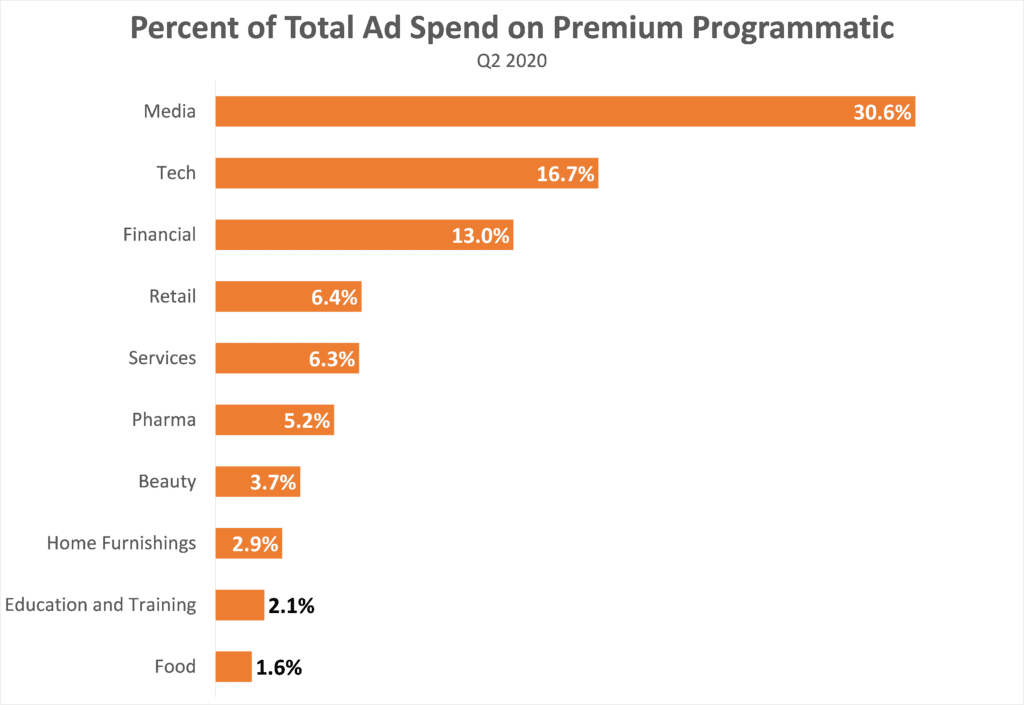Programmatic spending is up in 2020.
According to MediaRadar data, brands spent 11% more on programmatic between April and July than the same time period in 2019.
However, the percent of programmatic advertisers who utilize ad tech to purchase premium ad units—native, podcast and video—has stayed steady.
What are the latest trends in buying premium programmatic ads and who are the top buyers?
We encourage you to subscribe to our blog for the latest data surrounding the advertising industry. We will provide daily updates as COVID-19 continues to make its mark on the US economy.

Native, podcast and video programmatic ads drive engagement
Overall, programmatic advertising is faring well this year.
“For such a unique year, this year is following last year’s patterns pretty closely, albeit at a lower level,” said Andy Ellenthal, Staq’s CEO. “We expect to see a dip around Labor Day, the way we always do, but then we also expect it to come back.”
Of all the types of programmatic advertising, native, podcast, and video are premium purchases for advertisers.
Native mobile ads are advancing
One of the latest advancements to native programmatic advertising is Nativo’s latest release of Mobile Ads SDK. The SDK version 5 features:
- IAB Open Measurement (OM) SDK Support
- React Native Support
- Brand Safety Support
- CCPA & GDPR Compliance
According to publishers, they’re seeing about a 14% increase in CPM with this new version.
“As a mobile-first company, we realized that native ad formats are what drive increased engagement and retention among our app users,” said Co-Founder of Glow, Inc. Kevin Ho.
Programmatic podcast ads are positioned for growth
Native podcast ads are effective because they are tailored to a highly engaged audience and are intertwined with the flow of the show, often read by the show host.
Now, podcast advertising is leveling up with programmatic formatting. Programmatic podcast ads make ads personalized for specific audiences—based on location, weather, and demographics. There are a few specialized companies leading the charge in developing programmatic advertising for podcasts, namely Audry.
“Native advertising in podcasts used to outperform all other ad types on most performance metrics because targeting was very limited, and brands used aggressive radio style ads,” explained Niklas Hildebrand, the co-founder of Audry. “With programmatic podcast advertising, this is no longer the case. The new generation of podcast ads are not only more targeted, but the assets themselves can be dynamically assembled for every listener and designed to fit the medium’s auditory style.”
This type of advertising is still in its infancy, but is already demonstrating many advantages. These benefits include scalability, better attribution data and improved relevance to audiences.
Programmatic video
A Hubspot report in 2017 that surveyed over 3,000 consumers found that video is the best type of content to attract people’s time and attention—and 54% of respondents said they wanted to see more video from brands they support.
People love video. That’s not changing any time soon, making programmatic video advertisements highly impactful. Advertisers can optimize their ad campaigns by making ads in the format that audiences want to see, plus reaping the benefits of targeted personalization, automation and scalability.
Advertisers can choose from several different types of programmatic video ad types, including:
- In-stream videos
- Pre-roll videos
- Mid-roll videos
- Post-roll videos
- Out-stream videos
- In-display videos
MediaRadar Insights
While the percent of digital advertisers utilizing programmatic tech is increasing, the percent of programmatic advertisers who utilize ad tech to purchase these types of premium ad units is not budging.
In Q2 2020, 10% of all programmatic advertisers were buying the above three formats programmatically, only down from 11% in Q2 2019.

The top buyer of premium programmatic ad formats is the media industry. In fact, they make up 31% of all dollars spent on premium programmatic placements. When looking at programmatic as a whole, media makes up only 15%.
The top buyers of premium programmatic ads include:
- PayPal
- Verizon
- Liberty Mutual
- Geico
- L’Oreal
Collectively, these five companies made up 10% of all programmatic ad spend on premium formats.
Another buyer among the top ten spenders this year is Biden for President.
As political campaigns heat up, more sites will increase their political coverage. In a year marked by social unrest and economic inequality, advertisers may change their buying behavior as the election draws closer.
We’ll continue to monitor how advertisers behave as the year closes out— Q4 in 2020 will not likely be typical.
For more updates like this, stay tuned. Subscribe to our blog for more updates on coronavirus and its mark on the economy.



